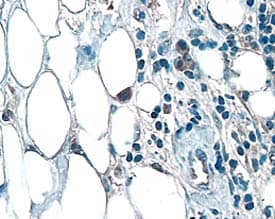Human FGF-3 Antibody
R&D Systems, part of Bio-Techne | Catalog # AF1206

Key Product Details
Species Reactivity
Applications
Label
Antibody Source
Product Specifications
Immunogen
Asp28-Arg212
Accession # NP_005238
Specificity
Clonality
Host
Isotype
Endotoxin Level
Scientific Data Images for Human FGF-3 Antibody
FGF‑3 in Human Breast Cancer Tissue.
FGF-3 was detected in immersion fixed paraffin-embedded sections of human breast cancer tissue using 10 µg/mL Goat Anti-Human FGF-3 Antigen Affinity-purified Polyclonal Antibody (Catalog # AF1206) overnight at 4 °C. Before incubation with the primary antibody tissue was subjected to heat-induced epitope retrieval using Antigen Retrieval Reagent-Basic (CTS013). Tissue was stained with the Anti-Goat HRP-DAB Cell & Tissue Staining Kit (brown; CTS008) and counterstained with hematoxylin (blue). View our protocol for Chromogenic IHC Staining of Paraffin-embedded Tissue Sections.Cell Proliferation Induced by FGF‑3 and Neutralization by Human FGF‑3 Antibody.
Recombinant Human FGF-3 (1206-F3) stimulates proliferation in the the NR6R-3T3 mouse fibroblast cell line in a dose-dependent manner (orange line). Proliferation elicited by Recombinant Human FGF-3 (0.3 µg/mL) is neutralized (green line) by increasing concentrations of Goat Anti-Human FGF-3 Antigen Affinity-purified Polyclonal Antibody (Catalog # AF1206). The ND50 is typically 1-4 µg/mL in the presence of heparin (1 µg/mL).Applications for Human FGF-3 Antibody
Immunohistochemistry
Sample: Immersion fixed paraffin-embedded sections of human breast cancer tissue subjected to Antigen Retrieval Reagent-Basic (Catalog # CTS013)
Western Blot
Sample: Recombinant Human FGF-3 (Catalog # 1206-F3)
Neutralization
Formulation, Preparation, and Storage
Purification
Reconstitution
Formulation
Shipping
Stability & Storage
- 12 months from date of receipt, -20 to -70 °C as supplied.
- 1 month, 2 to 8 °C under sterile conditions after reconstitution.
- 6 months, -20 to -70 °C under sterile conditions after reconstitution.
Background: FGF-3
Fibroblast Growth Factor 3 (FGF-3) belongs to the large FGF family which has at least 23 members (1, 2). All FGF family members are heparin-binding growth factors with a core 120 amino acid (aa) FGF domain that allows for a common tertiary structure. FGFs are expressed during embryonic development and in restricted adult tissues. They act on cells of mesodermal and neuroectodermal origin to regulate diverse physiologic functions including angiogenesis, cell growth, pattern formation, embryonic development, metabolic regulation, cell migration, neurotrophic effects and tissue repair (3, 4). Signaling receptors for FGFs are type I transmembrane receptor tyrosine kinases belonging to the Ig superfamily. Four distinct but related classes of FGF receptors, FGF R1, 2, 3, and 4, exist. Through alternative splicing, multiple isoforms for FGF R1, 2 and 3, with distinct ligand recognition profiles, are also generated (4).
The FGF-3 gene, originally designated int-2, was first identified as a proto-oncogene activated in mouse mammary tumors by proviral integration (2). Amplification of this gene has also been found frequently in human tumors. Human FGF-3 cDNA predicts a 239 aa precursor protein with a 17 aa signal peptide and a 222 aa secreted mature protein with one potential N-linked glycosylation site (1). Human and mouse FGF-3 share 88% aa sequence identity. The Xenopus and mammalian secreted FGF-3 are processed proteolytically at both the N- and C-terminus (5). FGF-3 binds with high-affinity to the IIIb isoforms of FGF R1 and FGF R2. FGF-3 also binds the IIIc isoform of FGF R2, but with lower affinity (6). FGF-3 has been implicated in the induction of inner ear development (7). Studies have suggested that FGF-3 and FGF-8 function synergistically in otic placode induction and during neuronal development to regulate dorsoventral axis formation (8-10). During development, the activities of FGF-3 and FGF-8 are regulated negatively by the sprouty family proteins and by Sef (similar expression to fgf genes), a transmebrane protein that shares intracellular sequence similarities with the IL‑17 receptor (10).
References
-
Brookes, S. et al. (1989) Oncogene 4:429.
-
Dickson, C. et al. (1989) Prog. Growth Factor Res. 1:123.
-
Goldfarb, M. (1996) Cytokine and Growth Factor Reviews 7:311.
-
Green, P. et al. (1996) BioEssays 18:639.
-
Antoine, M. et al. (2000) Cell Growth Differen. 11:593.
-
Kohl, R. et al. (2002) J. Biol. Chem. 277:32760.
- Represa, J. et al. (1991) Nature 353:561.
- Maroon, H. et al. (2002) Development, 129:2099.
- Walshe, J. et al. (2002) Current Biol. 12:1117.
- Furthauer, M. et al. (2002) Nature Cell Biol. 4:170.
Long Name
Alternate Names
Entrez Gene IDs
Gene Symbol
UniProt
Additional FGF-3 Products
Product Documents for Human FGF-3 Antibody
Product Specific Notices for Human FGF-3 Antibody
For research use only

